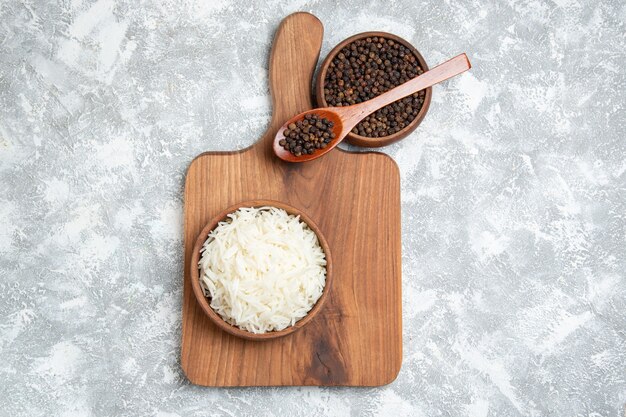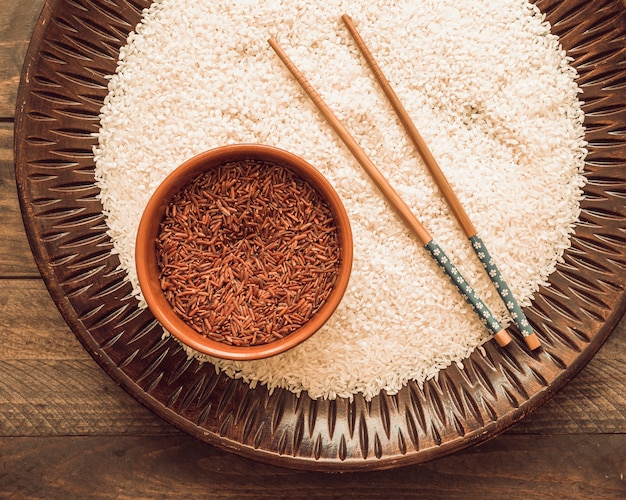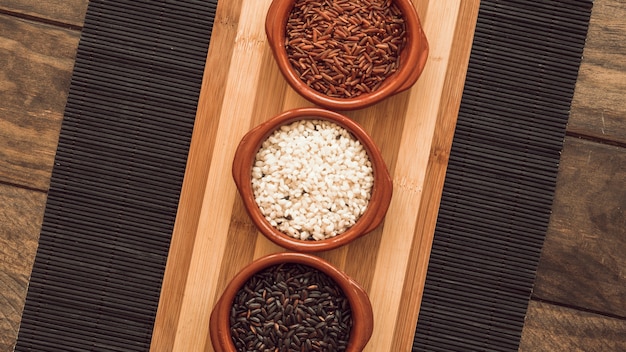Let's face it, there's nothing quite like a perfectly cooked pot of brown rice. It's that fluffy, nutty goodness that elevates any meal, whether it's a simple weeknight dinner or a fancy feast. But I know the struggle – burnt rice, mushy rice, or rice that's just plain bland. Well, fear not, my fellow rice enthusiasts! I've spent years perfecting my brown rice game, and I'm here to share my secrets. Grab your favourite mug, brew a cuppa, and let's dive in!
(Part 1) The Basics: Unlocking the Secrets of Brown Rice

Brown Rice: The whole grain Champion
Imagine a rice that's not just a blank canvas but a flavourful, nutrient-packed powerhouse. That's brown rice for you. It's the whole grain, with the bran and germ intact, giving it its signature nutty flavour and chewy texture. This also means it's a treasure trove of fibre, vitamins, and minerals that white rice simply can't match. Think of it as the superhero of the rice world!
Choosing Your Rice: A Variety for Every Taste
You've got options, my friend! While long-grain brown rice is the classic choice, known for its fluffy, separate grains, there are other varieties to explore. short-grain brown rice is stickier and perfect for sushi, while medium-grain falls somewhere in between. Don't be afraid to experiment!
Storing Your Rice: Keeping it Fresh and Flavorful
We've all been there – opening a bag of rice only to discover it's gone stale. The key to preserving your rice's freshness and flavour is simple. Store it in an airtight container, away from direct sunlight and heat. Think of it as a little rice haven!
(Part 2) The Essential Equipment: Your Rice-Cooking Arsenal

Now, let's talk tools! You don't need a fancy rice cooker to cook perfect brown rice. A few basic essentials are all you need to get started.
The Right Pot: A Sturdy Foundation for Success
A good, heavy-bottomed saucepan is your best friend when it comes to cooking rice. It distributes heat evenly, ensuring that your rice cooks evenly, without any burnt or undercooked bits. If you're a gadget enthusiast, a rice cooker is a great option, but I personally prefer the simplicity of the stovetop method.
Measuring Cups and Spoons: Precision is Key
We're talking about the perfect rice-to-water ratio here, so you need accurate measuring tools. A measuring cup for the rice and another for the water is essential for consistent results. Don't rely on eyeballing it!
Strainer: Washing Away Excess Starch
A fine-mesh strainer is a must-have for rinsing your rice. It helps remove excess starch, which can make your rice sticky and gummy. Trust me, it's a small step that makes a big difference!
(Part 3) The Rinsing Ritual: Why It's Worth the Effort

Rinsing your rice before cooking might seem like an extra step, but it's a game-changer. Think of it as a mini spa treatment for your rice.
Removing Excess Starch: Fluffy Grains, Happy You
Brown rice naturally contains starch, which can make the grains stick together and create a clumpy texture. Rinsing helps remove that excess starch, resulting in fluffy, separated grains that are a joy to eat.
Boosting Texture: Light and Airy Rice
Rinsing also contributes to a lighter, airier texture. The grains are less likely to stick together, leading to a more enjoyable eating experience.
Cleaning Up Impurities: A Safety Net for Your Rice
Even though it's rare, there might be tiny bits of debris or foreign objects in your rice. Rinsing helps remove these impurities, ensuring a clean and safe meal.
(Part 4) The Perfect rice-to-water ratio: Finding Your Sweet Spot
This is where the magic happens! The key to perfect rice is a precise rice-to-water ratio. While the general rule is 1:1.5 (one cup of rice to 1.5 cups of water), you might need to adjust depending on the type of rice and your preferred cooking method.
Adjusting for Different types of rice: Long-grain vs. Short-grain
For long-grain brown rice, the 1:1.5 ratio is spot-on. However, for short-grain rice, you'll need slightly less water, around 1:1.25.
Experimentation is Key: Finding Your Ideal Balance
Don't be afraid to experiment! If you find your rice is a bit dry, add a bit more water next time. If it's too mushy, reduce the water slightly. The goal is to find the perfect balance for your taste buds.
(Part 5) The Cooking Process: A Step-by-Step Guide to Success
Alright, now that you're armed with knowledge, let's get cooking! Follow these steps, and you'll be on your way to rice perfection.
Step 1: Rinsing the Rice: A Gentle Cleansing
Grab your strainer and hold it under cold running water. Pour in your rice and gently swirl it around, letting the water wash away excess starch and impurities. Keep rinsing until the water runs clear.
Step 2: Bringing the Water to a Boil: A Hot Start
Place your saucepan on the stove and add water. Make sure your saucepan is large enough to accommodate the rice and water without overflowing. Bring the water to a rolling boil.
Step 3: Adding the Rice: Merging Rice and Water
Once the water is boiling, carefully add your rinsed rice to the saucepan. Give it a good stir to ensure all the grains are submerged in the hot water.
Step 4: Simmering and Steaming: The Transformation Begins
Cover the saucepan with a tight-fitting lid and reduce the heat to a low simmer. Let the rice simmer for about 40-45 minutes, or until all the water has been absorbed. You'll see steam escaping from the lid – that's the magic happening!
Step 5: Resting the Rice: The Finishing Touch
Once the rice has cooked, remove it from the heat and let it rest for 5-10 minutes, covered. This crucial step allows the rice to absorb any remaining moisture, resulting in fluffy, delicious grains.
(Part 6) The Fluff Factor: Achieving that Perfect Texture
You've followed the steps, your rice is cooked, but it's not quite there yet. We need to unlock that fluffy magic.
The Fork Trick: Aerating for Lightness
After resting, grab a fork and gently fluff the rice. This helps to separate the grains and create that light, airy texture we crave.
The Towel Trick: Absorbing Excess Moisture
For a touch of extra fluffiness, wrap a clean kitchen towel around the lid of the saucepan while the rice is resting. The towel will absorb any excess moisture, resulting in even fluffier rice.
The Patience Factor: Giving Rice Time to Breathe
Don't rush the resting process! It's best to let the rice rest for at least 5 minutes before fluffing it up. This allows the grains to fully absorb the moisture and achieve their full fluffy potential.
(Part 7) Beyond the Basics: Expanding Your Rice Repertoire
Let's get creative! There are more ways to cook brown rice than just the stovetop.
Cooking Rice in the Oven: A Hands-Off Approach
Preheat your oven to 350°F (175°C). Transfer the rice and water to an oven-safe dish, cover tightly with foil, and bake for 45-50 minutes. This method is great for a hands-off approach.
Cooking Rice in a Rice Cooker: Effortless Convenience
Rice cookers are a godsend for busy cooks! Simply follow the instructions provided with your specific model. Most rice cookers have settings for different types of rice, ensuring perfect results every time.
Cooking Rice in the Microwave: A Quick Fix
In a pinch, you can even cook rice in the microwave. However, this method can be a bit more unpredictable and might require some experimentation.
(Part 8) Adding Flavour: Elevating Your Rice Game
Just because brown rice is simple doesn't mean it has to be bland. Here are some tips for turning your rice into a flavour sensation.
Herbs and Spices: A Symphony of Taste
A sprinkle of herbs like parsley, cilantro, or chives adds a burst of freshness. You can also use spices like cumin, turmeric, or paprika to create warmth and depth.
Garlic and Onion: Aromatic Delights
Sautéing some garlic and onion in the pot before adding the rice adds a delicious, savory depth of flavour.
Citrus Zest: A Brightening Touch
A touch of lemon or lime zest brightens up your rice and adds a citrusy zing. It's a simple but effective way to elevate your dish.
(Part 9) brown rice recipes: A Taste of Inspiration
Ready to put your newfound knowledge to the test? Here are some delicious brown rice recipes to inspire you.
Simple brown rice salad: Fresh and Flavorful
1 cup cooked brown rice
1/2 cup chopped cucumber
1/4 cup chopped red onion
1/4 cup chopped fresh parsley
1/4 cup crumbled feta cheese
2 tablespoons olive oil
1 tablespoon lemon juice
Salt and pepper to taste
Combine all ingredients in a bowl and toss to coat. Chill for at least 30 minutes before serving. This simple salad is perfect for a light lunch or side dish.
Brown Rice and Black Bean Burrito Bowls: A Hearty and Flavorful Meal
1 cup cooked brown rice
1 can black beans, rinsed and drained
1/2 cup chopped salsa
1/4 cup chopped avocado
1/4 cup shredded cheese
1/4 cup sour cream or Greek yogurt
Hot sauce to taste
Combine all ingredients in bowls and enjoy! This is a customizable and satisfying meal that can be adjusted to your liking.
Brown rice pudding: A Warm and Comforting Dessert
1 cup cooked brown rice
1 cup milk
1/2 cup sugar
1/4 cup raisins
1 teaspoon vanilla extract
1/4 teaspoon cinnamon
Combine all ingredients in a saucepan over medium heat. Cook, stirring occasionally, until the pudding thickens. Serve warm or cold. This comforting dessert is perfect for a cozy evening.
(Part 10) Brown Rice and Health: Why It's a Superfood
Brown rice isn't just delicious; it's a nutritional powerhouse that benefits your health in numerous ways.
Fiber Powerhouse: Digestive Delight
Brown rice is an excellent source of dietary fiber, which helps regulate digestion, promotes feelings of fullness, and helps keep blood sugar levels stable.
Packed with Nutrients: A Vitamin and Mineral Treasure Chest
It's also a good source of essential vitamins and minerals, including manganese, magnesium, selenium, and phosphorus. These nutrients play vital roles in everything from energy production to bone health.
Low Glycemic Index: Blood Sugar Management
Brown rice has a lower glycemic index than white rice, meaning it doesn't cause a rapid spike in blood sugar levels. This makes it a better choice for people with diabetes or who are trying to manage their weight.
(Part 11) FAQs: Your Brown Rice Queries Answered
Got questions? I've got answers. Here are some common questions about cooking brown rice.
How Long Does Cooked Brown Rice Last?
Cooked brown rice can last in the fridge for up to 4 days. Make sure to store it in an airtight container to maintain its freshness.
Can You Reheat Brown Rice?
Absolutely! You can reheat brown rice on the stovetop, in the microwave, or even in the oven. Just be sure to add a little bit of water or broth to prevent it from drying out.
What Can You Do with Leftover Brown Rice?
Leftover brown rice is a versatile ingredient that can be used in a variety of dishes. You can use it to make rice salads, stir-fries, or even breakfast porridge. Get creative!
Why Is My Brown Rice Mushy?
If your brown rice is mushy, it's probably because you used too much water or cooked it for too long. Next time, try using less water and checking the rice regularly to see if it's cooked through.
How Do You Make Brown Rice Fluffy?
The key to fluffy brown rice is using the right ratio of rice to water, rinsing the rice properly, and letting it rest after cooking. Follow the steps outlined in this guide, and you'll be on your way to fluffy rice heaven.
(Part 12) The Final Word: Mastering the Art of Brown Rice
And there you have it, the ultimate guide to cooking perfect brown rice every time. It's a simple yet versatile dish that can be enjoyed in countless ways. Remember, it's all about practice and experimentation. So, get in the kitchen, grab your rice, and have fun! You'll be a brown rice master in no time.
Everyone is watching

Corn on the Cob: The Ultimate Guide to Perfectly Cooked Ears
Healthy MealsAh, corn on the cob. Just the name evokes images of sunny days, barbecues, and that sweet, juicy flavour that ...

Perfect Pork Roast Oven Cooking Time: A Guide to Delicious Results
Healthy MealsThere's something truly satisfying about a perfectly roasted pork. The aroma alone is enough to make your mout...

Ham Cooking Time: How Long to Bake, Smoke, or Boil a Delicious Ham
Healthy MealsAh, ham. It's a classic, isn't it? A real crowd-pleaser, especially around holidays. And when done right, it'...

Scallops: The Ultimate Guide to Perfect Cooking
Healthy MealsAh, scallops. Those delicate, sweet, and utterly delicious morsels of the sea. They hold a special place in my...

Spaghetti Squash: The Ultimate Guide to Cooking and Serving
Healthy MealsRemember that time you saw spaghetti squash at the supermarket, looking all bumpy and strange, and thought, "W...
